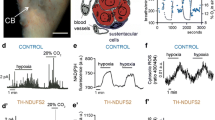Abstract
The mammalian carotid body maintains a high level of chemoreceptor output and provides support for increased ventilatory drive over an extended period in animals chronically exposed to a low O2 environment (i.e., chronic hypoxia, CH; Bisgard, 2000). Important features of carotid body adaptation to CH include hypertrophy and hyperplasia of (O2-sensitive type I cells, and marked dilation of surrounding microvascular elements (McGregor et al 1984; Laidler & Kay, 1975). Although little is known about the cellular mechanisms which mediate these remarkable morphological changes (Pequignot et al 1987; Bisgard, 2000), similar (O2-sensitive changes occur in the lung and heart where CH elicits constriction and thickening of vessel walls in the pulmonary circuit and hypertrophy of the right ventricle, resulting in pulmonary hypertension (Rabinovitch et al., 1979).
Access this chapter
Tax calculation will be finalised at checkout
Purchases are for personal use only
Preview
Unable to display preview. Download preview PDF.
Similar content being viewed by others
References
Bisgard,G.E., 2000, Carotid body mechanisms in acclimatization to hypoxia Resp. Physiol. 121: 237-246.
Christou, H., Yoshida, A., Arthur, V., Morita, T., and Kourembanas, S., 1998, Increased vascular endothelial growth factor production in the lungs of rats with hypoxia-induced pulmonary hypertension. Am. J. Respir. Cell. Mol Biol. 18(6): 768-776.
Deindl, E., Buschmann, I, Hoefer, I.E., Podzuweit, T., Boengler, K., Vogel, S., van Royen, N., Fernandez, B., and Schaper, W., 2001, Role of ischemia and of hypoxia-inducible genes in arteriogenesis after femoral artery occlusion in the rabbit. Circ. Res. 89: 779-786.
Ferrara, N., 1999, Role of vascular endothelial growth factor in the regulation of angiogenesis. Kidney Int'l 56: 794-814.
Forsythe, J.A., Jiang, B.-H., Iyer, N.V., Agani, F., Leung, S.W., Koos, R.D., and Semenza, G.L., 1996, Activation of vascular endothelial growth factor gene transcription by hypoxia-inducible factor 1. Molec. Cell. Biol. 16(9): 4604-4613.
Ishida, A., Murray, J., Saito, Y., Kanthou, C, Benzakour, O., Shibuya, M., and Wijelath, E.S., 2001, Expression of vascular endothelial growth factor receptors in smooth muscle cells. J. Cell. Physiol. 188:359-368.
Ladoux, A., and Frelin, C, 1993, Hypoxia is a strong inducer of vascular endothelial growth factor mRNA expression in the heart. Biochem. Biophys. Res. Comm. 195(2): 1005-1010.
Laidler, P., and Kay, J.M., 1975, A quantitative morphological study of the carotid bodies of rats living at a simulated altitude of 4300 meters. J. Path. 117: 183-191.
Laidler, P., and Kay, J.M., 1978, A quantitative study of some ultrastructural features of the type I cells in the carotid bodies of rats living at a simulated altitude of 4300 meters. J. Neurocytol. 7: 183-192.
McDonald, D.M., 1983, A morphometric analysis of blood vessels and perivascular nerves in the rat carotid body. J. Neurocytol. 12: 155-199.
McGregor, K.H., Gil, J., and Lahiri, S., 1984, A morphometric study of the carotid body in chronically hypoxic rats. J. Appl. Physiol: Respirat. Environ. Exercise Physiol. 57: 1430-1438.
Minchenko, A., Bauer, T., Salceda, S., and Caro, J., 1994, Hypoxic stimulation of vascular endothelial growth factor expression in vitro and in vivo. Lab. Invest. 71(3): 374-379.
Pequignot, J.-M., Hellstrom, S., and Johansson, C, 1987, DL-propranolol inhibits the vascular changes in the rat carotid body induced by long-term hypoxia Virchows Arch. A 411: 331-336.
Pequignot, J.M., and Hellstrom, S., 1983, Intact and sympathectomized carotid bodies of long-term hypoxic rats. Virchows Arch. 400: 235-243.
Price, D.J., Miralem, T., Jiang, S., Steinberg, R., and Avraham, N., 2001, Role of vascular endothelial growth factor in the stimulation of cellular invasion and signaling of breast cancer cells. Cell Growth & Differentiation 12: 128-138.
Rabinovitch, M., Gamble, W., Nadas, A.S., Miettinen, O.S., and Reid, L., 1979, Rat pulmonary circulation after chronic hypoxia: hemodynamic and structural features. Am. J. Physiol 236(6): H818-H827.
Sondell, M., Lundborg, G., and Kanje, M., 1999, Vascular endothelial growth factor stimulates Schwann cell invasion and neovascularization of acellular nerve grafts. Brain Res. 846: 219-228.
Thomas, K.A., 1996, Vascular endothelial growth factor, a potent and selective angiogenic agent. J. Biol Chem. 271(2): 603-606.
Tuder, R.M., Flook, B.E., and Voelkel, N.F., 1995, Increased gene expression for VEGF and the VEGF receptors KDR/Flk and Fit in lungs exposed to acute or to chronic hypoxia. J. Clin. Invest. 95: 1798-1807.
Weibel, E.R., 1979, Serological Methods. Academic Press: London, New York.
Author information
Authors and Affiliations
Editor information
Editors and Affiliations
Rights and permissions
Copyright information
© 2003 Springer Science+Business Media New York
About this paper
Cite this paper
Chen, J., Dinger, B., Jyung, R., Stensaas, L., Fidone, S. (2003). Altered Expression of Vascular Endothelial Growth Factor and FLK-1 Receptor in Chronically Hypoxic Rat Carotid Body. In: Pequignot, JM., Gonzalez, C., Nurse, C.A., Prabhakar, N.R., Dalmaz, Y. (eds) Chemoreception. Advances in Experimental Medicine and Biology, vol 536. Springer, Boston, MA. https://doi.org/10.1007/978-1-4419-9280-2_74
Download citation
DOI: https://doi.org/10.1007/978-1-4419-9280-2_74
Publisher Name: Springer, Boston, MA
Print ISBN: 978-1-4613-4873-3
Online ISBN: 978-1-4419-9280-2
eBook Packages: Springer Book Archive




